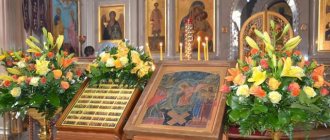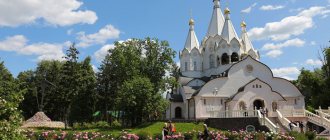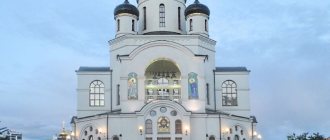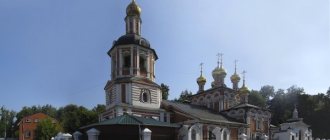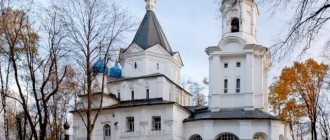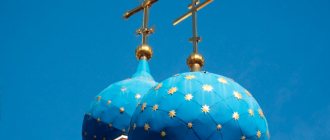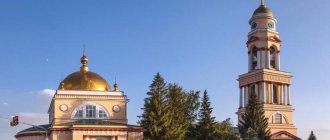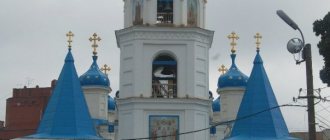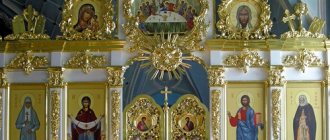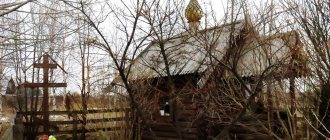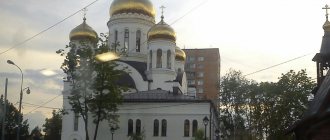In the very center of the capital there is an ancient church, well known to Muscovites as the Temple of Antipas of Pergamon on the Kolymazhny Yard. For many years it housed first art courses, then a library, and only in the years following the changes introduced into our lives by perestroika did it open its doors to parishioners again. Our short essay about her.
Church near the sovereign's stables
During the reign of Ivan the Terrible, the royal stables were located northwest of the Kremlin. Since ancient times, this place was called Chertolye, and in subsequent years it received the name Kolymazhny Dvor, although the sovereign's carriages hardly looked like rattles. It is known that it was first mentioned in historical documents dating back to 1365.
Since nothing was done in those years without Heavenly protection, two churches were erected there - in the name of the Conception of John the Baptist and in honor of the holy great martyr Antipius of Pergamon. The first has not survived to this day (it was dismantled in the 18th century), but the second still stands today, reminding Muscovites of the days of the long past.
At first, the temple of Antipas of Pergamon in the Kolymazhny yard was wooden, as evidenced by a record made in 1530. But after stables with horses appeared on its western side in 1547, which were ridden (no joke!) by the sovereign himself, it was rebuilt and the walls were built of stone. The main throne, and it was double-throne, was consecrated, as before, in the name of the faithful disciple of John the Theologian - Bishop of the Pergamon Church Antipius, who glorified the Lord by his martyrdom. His memory is still celebrated by the Orthodox Church on April 24.
Church of St. Antipas of Pergamon at the Kolymazhny yard
On quiet Volkhonka, next to the museum, lies the modest ancient Church of Antipas the Martyr. Her fate turned out to be connected with the tragic and glorious pages of the chronicle of Russian history. For centuries, Muscovites offered prayers in it, and finally the tradition was resumed.
It is not known why in old Moscow and precisely in this place the church was consecrated in the name of St. Antipas, Bishop of Pergamon, disciple of the holy Apostle John the Theologian. His pastoral service fell during the time of the terrible emperor Nero, who demanded constant sacrifice to pagan idols, and execution or exile awaited those who disobeyed. St. himself John the Theologian was then exiled to the island of Patmos in the Aegean Sea. The preaching of Saint Antipas kept his flock from worshiping “domestic gods,” which the pagan priests accused him of. They martyred the ascetic, throwing him into a red-hot furnace, but the fire did not touch the body of the martyr - according to legend, the saint, who was constantly praying, seemed to fall asleep. Christians buried him in Pergamon, and healings began at the tomb. Especially St. Antipas is famous for healing toothaches.
The reason for the dedication of the church on Volkhonka has remained a secret of history. Another mystery was the time of its construction. Unconditionally, it dates back to the 1530s, but there is a version that the first wooden church on this site was built by Aleviz Fryazin himself in 1514 or 1519. It is sometimes believed that he built another temple here, in the name of St. Metropolitan Peter, and in its place a new Antipievskaya Church was later built (or rebuilt). The third mystery was the name of the temple builders. Scholars unanimously admit that the Skuratov family, whose estate was closely adjacent to it on the eastern side, took part in the construction of the temple, and sometimes timidly name the name of the main, famous representative of this family - Grigory Lukyanovich Belsky, better known as Malyuta Skuratov.
It is known that this church originally appeared in the settlement of the royal grooms, who lived here, near the Kremlin, since the 14th century. After the terrible fire of 1547, the Tsar’s Stable Yard itself was moved here from the Kremlin, which is why the local suburban church began to be called “that of the Sovereign’s large stables.” Previously, the Tsar’s Stable Yard was located in the Kremlin, near the Commandant’s Tower, which was then called Kolymazhnaya, from the carriages that were made for the Tsar’s court.
The first wooden church, built for the royal grooms, possibly by Aleviz Fryazin, the court architect of the great sovereign Vasily III, was soon replaced by a stone one, which indicates the relative wealth of the parishioners. Its architecture and stylistic devices (like the sun laid out in a dome, small-sized “Aleviz” brick) indicate a strong influence of Italian architecture or imitation of it, which confirms the version of the authorship of Aleviz, who could well have built a suburban church for the royal servants.
The temple, which has survived to this day, represents a complex architectural layering, as it was rebuilt in different eras - from the 16th century to 1901. It is believed that at its core only the building from 1596 has survived, but over the centuries it has acquired new additions. The rarest feature of the Antipievskaya Church was two altar apses instead of the traditional one: in the large apse there was an altar with the main altar, in the other, smaller one there was a chapel. A huge number of chapels became another feature of the church. The first was a chapel in the name of St. Gregory Dekapolit, built in the southern apse and had its own blind dome. Scientists attribute its construction to the Skuratov family. According to one version, it was built in the name of the heavenly patron by Malyuta Skuratov himself, who had his own Moscow courtyard near this temple.
The location of Malyuta's estate still causes a lot of scientific controversy. Rumor attributed to him the possession of clerk Averky Kirillov on the opposite bank of the Moscow River. Other scientists believe that Skuratov’s house, as a Duma nobleman and especially close to the Tsar (in Aleksandrovskaya Sloboda, he held the position of “sexton”) could even be located in the Kremlin, but this is an assumption. During the reign of Ivan the Terrible, this territory (from Prechistenskaya Embankment to Bolshaya Nikitskaya Street) was given over to the oprichnina. And probably Malyuta actually received a yard here to live in - on what is now Volkhonka, near the Cathedral of Christ the Savior. And his personal stables, according to legend, were located in the area of Maly Vlasevsky Lane, near Prechistenka.
At that time, the Antipyevskaya Church definitely stood here. According to legend, Ivan the Terrible married his next wife in it. The first Russian Tsar honored this saint, and among his family prayer shrines was the tooth of St. “Ontypia the Great”, bound in silver. There is another version why Grozny chose this area - his Oprichnaya Palace stood nearby. (Presumably, the remnant of this palace has survived to this day; it is located in the depths of the courtyard of the Auditorium building of Moscow State University, which is now occupied by the Faculty of Journalism.) At the end of the 14th century, on a high hill in Old Vagankovo (where Pashkov’s house now stands), the palace of the Grand Duchess was erected Sofia Vitovtovna, wife of Vasily I, great-great-grandfather of Ivan the Terrible. Grozny himself settled in those parts, having declared the oprichnina. One of the local underground passages headed towards Kolymazhny Dvor, where the Skuratovs’ estate was located. Perhaps Malyuta himself used it more than once. Scientists are now putting forward a fantastic assumption that it is on this territory, in the dungeons between the Kremlin and the oprichnik’s house, that the library of Ivan the Terrible, which was sought in the Kremlin, Kolomenskoye and Aleksandrovskaya Sloboda, is hidden.
It is reliably known that in the 17th century, the Skuratov family estate, which belonged to the descendants of Malyuta’s brother, Ivan Skuratov, was closely adjacent to the Antipievskaya Church on the eastern side. The Antipievskaya Church served as their family tomb. From here came another version - the chapel of St. Grigory Dekapolit could have been arranged by Malyuta’s relatives themselves after his death.
The Skuratov-Belsky family did not previously have a high position. The Skuratovs were their family nickname (from skurat - “skin”, “rough skin”), which was already borne by the great-grandson of the ancestor. Actually, their family name was Belsky, according to legend, from the Polish nobleman Stanislav Belsky, who came to serve Vasily I Dmitrievich, the son of Dmitry Donskoy. His great-grandson, Prokofy Zinovievich Skurat, accompanied Elena Glinskaya, mother of Ivan the Terrible, on trips. The name Malyuta became a mystery: either it was an ordinary Russian name given to a baby at birth, who was named Gregory at baptism. (His brother also had a similar name - Nezhdan). Or Malyuta is the nickname of Grigory Belsky for his short stature, which is shared by most historians.
However, the main evidence of the location of his house on Volkhonka was an archaeological find - a grave stone slab discovered during the dismantling of the Church of the Praise of the Virgin Mary, which stood next to the Cathedral of Christ the Savior, for the construction of the Palace of the Soviets. The inscription on it said that Malyuta Skuratov, who was killed in the Livonian War, was buried here. By the way, information about this find was not gleaned from the depths of the Internet, as was recently written in one online publication, but in the book of the famous Soviet historian of Moscow P.V. Sytin “From the history of Moscow streets,” a contemporary of that event.
Previously, it was assumed that the guardsman, killed in January 1573 during the storming of the Livonian fortress of Paide, was buried in the Joseph-Volokolamsk monastery, which Ivan the Terrible especially loved. According to legend, the bleeding Malyuta Skuratov, brought to the monastery, repenting of his atrocities, himself asked to be buried at the monastery gates, so that everyone who entered would trample his ashes underfoot. Maybe Malyuta was reburied at the request of her relatives. They retained the family estate, had other royal favors, and Skuratov’s widow even received a lifelong pension. Malyuta himself had no direct heirs in the male line. His only son Maxim died early, and his three daughters were successfully married. The eldest became the wife of Ivan Glinsky, cousin of Grand Duchess Elena Glinskaya, the Tsar’s mother! Another daughter, Maria Grigorievna, married to the boyar Boris Godunov, eventually turned out to be a queen herself. The third married boyar Dmitry Ivanovich Shuisky, brother of Tsar Vasily Shuisky. Rumor accused her of poisoning at a feast the national hero, commander Mikhail Skopin-Shuisky, who was their relative.
And until the middle of the 17th century, the estate on Volkhonka belonged to the descendants of Malyuta’s brother, Ivan Skuratov, who became the founder of this branch. Patriarch Filaret himself performed the funeral service and buried here in 1627 his great-grandson, Dmitry Fedorovich Skuratov, who served as governor in Vyazma and Mtsensk. His son Peter, also a voivode, turned out to be the last owner of the Moscow estate, which passed from him into the possession of Prince Mikhail Mikhailovich Temkin-Rostovsky, whose name was on the list of parishioners of the Antipievsky Church. His family also turned out to be connected with the oprichnina: one of his relatives served Prince Vladimir Andrevich Staritsky, whom Grozny accused of encroaching on the throne and ordered to kill. The boyar joined the oprichnina, but in 1572 he was executed along with his son. And Prince Mikhail himself was among those who “had a hand,” that is, those who signed the famous Council Code of 1649.
Of course, the Antipievskaya Church was connected by historical ties not only with the name of the Skuratovs. The dedication to the saint, famous for his healing of toothache, attracted all of Moscow to the walls of the temple. Kings, nobles, and ordinary townspeople prayed here, asking St. Antipas of health, as well as Muscovites whose houses were in the parish, among whom there were many outstanding and interesting people. Many of them, like the Skuratovs, had funeral services in this church and were buried by the patriarch himself.
Tsar Alexei Mikhailovich more than once went on pilgrimage “to Antipius” from the very first year of his reign. It is known that he once put “two silver teeth” to the image of the miracle worker - according to custom, to the icon of St. Antipy was presented with pendants with an image of a tooth and a prayer for health. Under the Quiet Sovereign, the old sovereign's Stable Yard became Kolymazhny - on the site of the museum, a new stone building was built, where instead of stables, under a canopy, a storage facility for the royal carriages and “everything needed” for the highest excursions was built.
And later the church acquired a new toponymic name - “what’s on the Lazy market”, according to which the whole Volkhonka was called Lenivka in the old days. Lazy markets were the oldest city markets, where peasants traded from carts, and according to this method of trading, markets were called lazy, not lively. Lazy markets usually arose in the open, on the outskirts, along the roads, where carts could be freely placed. One of them arose in Zamoskvorechye on the site of the future Pyatnitsky market, and it was there that the first Lenivka in Moscow appeared: that was the name of the section of Pyatnitskaya Street from its beginning to Klimentovsky Lane. The second lazy market was in Zaneglimenye, which to this day has left the name of the tiny, shortest street in old Moscow near Volkhonka.
Another feature of the Antipievskaya Church was its many chapels. In addition to Grigorievsky, there were thrones in the name of St. Nicholas the Wonderworker, St. Catherine, built in the basement in 1773, (perhaps in honor of the Empress) and the Nativity of John the Baptist in the bell tower. The Nikolsky chapel, built back in the 17th century, was refurbished in 1739-41 by parishioner Prince S.A. Golitsyn, who later became the mayor of Moscow. And the beautiful bell tower was built only in 1798.
According to legend, the notorious fire that happened in Moscow in May 1737, in the fire of which the Kremlin Tsar Bell perished, began from the church of St. Antipas of the Martyr. Now there is information that this is not entirely true: in fact, a fire broke out in the Miloslavsky estate, which stood next to the church, where the fire started from a candle placed in the house near the icon. To understand the scale of the disaster that befell Moscow, it is enough to say that the Lefortovo Palace, which stood on the Yauza, also burned down in the flames. After 1812, on the site of the Miloslavsky estate, a wooden mansion was built for the actual state councilor Pavel Ivanovich Glebov, who became the successor of the third son in the elder Pushkin family, Lev, born in the spring of 1805. Glebov himself was a parishioner of the Antipyevskaya Church.
In the neighboring house, built, by the way, by Fyodor Shestakov, the architect of the Great Ascension, the famous writer of everyday life of the Moscow merchants P.A. Buryshkin lived since 1896. In this house there was a famous staircase, according to legend, which once inspired Griboyedov to describe the scene in “Woe from Wit.” And when the comedy was being prepared for theatrical production, a commission from the Moscow Art Theater came to the Buryshkins to take photographs and sketches “from nature.” After restoration, museum premises were set up here for a collection of engravings and drawings.
In the 18th century, a parishioner of the Antipyevskaya Church was the Duma clerk Gavriil Fedorovich Derevnin, the organizer of the stone Church of Elijah the Common on Ostozhenka - before that the famous Ilyinsky Church was wooden. In 1702, the clerk received the blessing of Metropolitan Stefan Yavorsky, and then was buried in the church he had newly built, and not in the Antipievskaya Church.
Another “celebrity” of the parish was “His Excellency the Privy Councilor and Cavalier” Prince Stepan Borisovich Kurakin, the brother of the “Diamond Prince”, the owner of Altufyev, who was friends with Krylov, Rokotov, Fonvizin. He was one of the founders and first matador (foreman) of the Moscow English Club, which then still occupied the Golitsyn estate on Strastnoy Boulevard, the head of the expedition of the Kremlin building, and the organizer of the famous Kurakinsky almshouse in Basmannaya Sloboda, founded according to the will of his father - the largest charitable institution in old Moscow. Kurakin Sr., having seen the Palace of Invalides in Paris, decided to found something similar in Moscow, with the dedication of St. Nicholas the Wonderworker. The will of the parent was fulfilled - the Kurakinsky almshouse with the house St. Nicholas Church was intended for charity for crippled Russian soldiers.
The Lopukhins, the Apraksins, and the Obolenskys were parishioners of the Antipievsky Church, due to its location in such an aristocratic area. In 1813, Major General Alexey Timofeevich Tutolmin, the son of a famous Moscow mayor who owned a magnificent palace on Goncharnaya Street, was listed in the parish of the temple. The general, however, remained more in the history of the Tver town of Staritsa, where he built the beautiful Assumption Cathedral in memory of his parents.
And at the beginning of the twentieth century, the artist Valentin Serov lived in the parish of the Antipievskaya Church. At that time, work had already begun on the creation of the Museum of Fine Arts - after the revolution, the fates of the museum and the temple were intertwined. Previously, back in 1830, the former Kolymazhny Yard was demolished (it had been in St. Petersburg for a long time), and its stone buildings were turned first into a riding arena, and then into a transit prison. In it, the Polish revolutionary Jan Dombrowski, the future hero of the Paris Commune, was waiting to be sent to Siberia, for whom the Moscow populists arranged an escape. Then the transit prison was transferred to Butyrki, and after much debate, the territory was given over for the construction of a great Museum, since it was the only free and suitable place for it in the center of Moscow. By the way, it was proposed to be created by Princess Zinaida Volkonskaya, who owned a mansion on Tverskaya, where the Eliseevsky grocery store later opened, but then there was not enough money for it.
The museum opened in 1912. There were only a few years left before the closure of the Antipievskaya Church. However, she managed to enter another, bright and tragic page in the history of Orthodox Moscow. In February 1922, His Holiness Patriarch Tikhon ordained Holy Martyr to the rank of deacon in this church, and soon to the rank of priest. Ilya Gromoglasov, canonized as holy new martyrs at the Jubilee Council of Bishops of the Russian Orthodox Church in August 2000. He was one of the most educated, learned Moscow priests: professor, master of theology, private associate professor of church law at Moscow University, member of the Society for the History of Ancient Manuscripts... In terms of his lecturing skills, he was compared to Klyuchevsky.
After the ordination of Fr. Ilya served in the Antipievsky Church for about a month, and already in March he was arrested as “a participant in meetings with Alexander Khotovitsky” - in the case of the seizure of church valuables from the Cathedral of Christ the Savior. There is a version that after being ordained as a priest in the Antipyevskaya Church, the priest secretly served in this church. He was a zealous opponent of requisition - Fr. Ilya was even accused of co-authoring the Message of Patriarch Tikhon regarding the confiscation of church valuables. His case was considered by the Moscow Revolutionary Tribunal, chaired by N. Krylenko, and although the prosecutor demanded capital punishment, he was given 1.5 years. Having been released under an amnesty, Fr. Ilya was appointed rector of the Resurrection Church in Kadashi, where the saint is now especially revered. After another arrest in 1925 and subsequent exile, he was banned from living in the capital. Father Ilya chose Tver and served in the local Church of the Burning Bush until his last arrest for “counter-revolutionary agitation.” He was shot on the Feast of the Entry, December 4, 1937, and therefore, with the blessing of His Holiness Patriarch Alexy II, his memory is celebrated on December 3, on the eve of the Twelfth Feast, and in the Cathedral of the New Martyrs of Russia. (Father Ilya found his last refuge in a common grave at the Tver Volyn cemetery.)
The Antipievskaya Church was closed in 1929. At that time, it was planned to open a “Neophilological Library” there, but living quarters were set up in the dilapidated building, and then it was transferred to the Museum for storage. In 1962, the ancient Antipyevsky Lane was renamed in honor of Marshal Shaposhnikov, who for a long time headed the General Staff of the Soviet Army. In those same years, the famous Soviet architect L.A. David restored the church. Having discovered an ancient structure at its core, he decided to apply the same technique as with the reconstruction of the Trifonov Church in Naprudny - to clear all the later buildings and restore it to its 16th-century appearance. The museum, which wanted to place a library there, was strongly opposed.
And in our time they began to ask for the temple to be returned to believers. They suggested praying there to the holy healer “according to the ancient rite.” In 1991, a community was formed and a rector was appointed, and on April 24, 2005, the first Divine Liturgy in many years took place.
One of Ivan the Terrible's favorite churches
According to legend, Tsar Ivan the Terrible married one of his wives in this church, but when and with which one is unclear, there are different opinions on this matter. Despite the fact that the church charter allows no more than four marriages, the loving sovereign managed to do it seven times - after all, the law is not written to kings. However, it is possible that the last three wives were not married to him.
It was no coincidence that the Temple of Antipas of Pergamon in the Kolymazhny Yard enjoyed the special attention of the formidable king - he considered the holy great martyr Antipas one of his heavenly patrons, and among the most revered family heirlooms he kept his tooth set in silver.
Hieromartyr Antipas, Bishop of Pergamon, is revered as the patron saint of dentists
Holy Martyr Antipas, Bishop of Pergamon
Saint Antipas, Hieromartyr Antipas, Bishop of Pergamon, has been revered in Russia since ancient times as a healer of toothache and patron of dentists; there are ancient churches in his honor in Suzdal and Vologda. His memorial day is celebrated on April 24.
April 24
Memorial Day of the Holy Martyr Antipas Bishop of Pergamon
According to his life, Antipas was a disciple of the Apostle John the Theologian and was the bishop of the Pergamon Church during the reign of Emperor Nero (54-68).
With his firm faith in the Son of God, he achieved that the inhabitants of Pergamum (the territory of modern Turkey) began to shy away from sacrifices to idols.
Antipas refused to stop preaching about Christ and making sacrifices to the pagan gods.
Enraged priests threw Antipas into a red-hot copper ox in the temple of Artemis - where sacrifices to idols were usually thrown, but even there the holy martyr continued to pray to God. His body was secretly buried by local Christians in Pergamon.
In the 5th century, a temple was erected over his tomb in Pergamon, and in the 9th century, a temple was built in Constantinople in the name of the holy martyr.
The miraculous relics of the heavenly patron of dentists are now kept on the Greek island of Patmos, in the monastery of the Holy Apostle John the Theologian.
Tomb of the Skuratovs
It is also known that the church near the royal stables became the family tomb of the Skuratov family, one of whom, Malyuta, who was the head of the guardsmen of Ivan the Terrible, went down in Russian history as perhaps the most bloodthirsty villain of the past centuries. By the way, there is reason to believe that he took an active (financial, of course) part in the construction of the church itself and was buried in it after his death in 1573.
After the territory on which Chertolye was located was given to the Oprichnina in 1565, and everyone who lived on it was evicted, houses for the tsar’s entourage began to be built there. Among them was the estate of the sovereign's steward Pyotr Skuratov, one of Malyuta's relatives, mentioned in documents from 1638. It was adjacent to the church fence.
Holy Hieromartyr Antipas of Pergamon
Celebration: April 11/24
GREATNESS
We magnify you, / Hieromartyr Antipo, / and honor your holy memory, / for you pray for us / Christ our God.
LIFE OF THE MARTYR ANTIPAS
During the reign of Emperor Dominian, a great persecution of Christians began, and decrees were sent to all princes and rulers so that Christians would unquestioningly obey the royal commands, accept the pagan faith and worship idols. Then a multitude of faithful appeared, fearlessly confessing the word of God, and the great courage of the martyrs who fought for Christ the Savior was revealed. At this time, the great apostle, Saint John the Theologian, was imprisoned on the island of Patmos, this pillar of the Church, the foundation of Christian truth and the preacher of the eternal Divinity of the Only Begotten Son of God. On Patmos, the Lord appeared to him in revelation among the seven lamps and commanded him to write to the seven angels, that is, to the bishops of the seven churches of Asia Minor, and to strengthen the hosts of the martyrs. At the same time, the Lord also remembered Saint Antipas, about whom the present story is presented. Antipas,” the Lord said to His disciple, “I know your deeds, and that you live where the throne of Satan is (Rev. 2:13). For Saint Antipas was the bishop of the Church of Pergamon. From these words of John’s revelation it is clear what a faithful witness of Christ Antipas was and what kind of people were the inhabitants of the city of Pergamum, which was the dwelling of Satan. Among them, Saint Antipas was like light in the midst of darkness, like a rose among thorns, like gold in mud, or, better to say, in a fiery furnace, according to what is written: like gold is tempted in a furnace (Wisdom 3:6).
There the law of nature was not observed and there was no prudence, but everyone took revenge for himself and the strong offended the weak, and he was considered courageous, kind and righteous who beat or killed Christians. And when the infidels so oppressed and disturbed Christian society, blessed Antipas, a man unshakable in faith and constant in virtue, was not at all embarrassed, but, as if changing his human nature to angelic, stood firmly and fearlessly against the enemies. Disregarding the threats of his tormentors, he often went out among the people and among them shone like the dawn, with the light of pure and right faith, driving away the darkness of idolatrous error. Therefore, the demons (whom the Hellenes considered to be gods) all fled from there, and not one of them dared to stay in Pergamum, where Saint Antipas lived. The demons appeared to their priests in dreams and said that they no longer tasted their sacrifices and did not smell the incense of the sacrificial, since the leader of the Christians was driving them away. Then the Hellenes became angry and rushed towards Antipas and, seizing him, dragged him to the place where they usually offered their vile sacrifices.
And the ruler said to him: “Are you that Antipas who himself does not fulfill the royal commands and teaches others the same and so interferes with our sacrifices that he does not allow any of the gods to be satisfied with the fat of the sacrificial? Because of you, the gods left our city, and there is a danger that some kind of misfortune befalls it, since they will no longer want to protect it. Enough for you to become stuck in Christian magic; now repent and obey our laws, so that the gods who own this beautiful city do not cease to care for us and protect us. And if you do not want to do this, and do not renounce your faith and despise our worship of God, then according to Roman law you will be subjected to a worthy punishment.”
Saint Antipas responded to this: “Know one thing, ruler, that I am a Christian and I do not at all want to obey the insane and wicked command of the king. But since your questions must be answered decently, listen to me. If your gods, whom you call the rulers of the entire universe, are driven away, as they themselves say, by mortal man, and if those whom you consider to be your protectors and intercessors themselves seek your help, then from here you can easily recognize your error. If they cannot punish for the insult caused to them and recognize themselves as defeated by one person, then how can they save the entire human race or even just one city from trouble? Having taken this into account, you must now at least abandon your destructive delusion and believe in Christ, who came down from heaven to save the human race. This Christ, at the end of the ages, will truly come to judge everyone and reward everyone according to his deeds, either torment or honor.”
After these words, the wicked grabbed the holy man and dragged him to the temple of Artemis, where the copper ox was located; Having heated this ox, they threw the holy martyr into it. Having made the sign of the cross, he prayed to God, crying out: “God, who has revealed to us the secret of our Lord Jesus Christ, hidden from the ages, through whom You have revealed to us the unknown depths of Your counsel, I thank You for all Your good deeds, because You save us who trust in You, and have granted me the honor at this hour to be included in the number of holy martyrs who suffered for Your holy name. Accept my spirit, which is now departing from this life, and let me find grace from You and from Your Only Begotten Son - and not only me, but also those who will live after me, make me participants in Your mercy, so that Your holy name may be glorified by all forever. Amen".
Saint Antipas prayed for a long time with these and similar words, tormented by the red-hot will. Then, having made a prayer for the whole world, he gave up his spirit into the hands of God, as if falling into a sweet sleep, and ascended to heaven, adorned with the glorious crown of martyrdom. Pious men took his holy relics and buried them with honor in the same city of Pergamum, and myrrh flowed from them, healing all sorts of human diseases for the glory of Christ our God, glorified with the Father and the Holy Spirit forever. Amen.
Based on the Lives of the Saints by St. Demetrius of Rostov.
IMAGE OF THE MARTYR ANTIPAS IN OUR TEMPLE
The half-length image of the Hieromartyr Antipas of Pergamon is the most ancient icon of our church, painted in the 1560s–1570s, during the reign of Tsar Ivan the Terrible. This is a fine example of Moscow icon painting, representing a saint who was especially revered in Rus' as a healer for toothache. His individual images are relatively rare in ancient Russian art. The iconography of our image corresponds to the descriptions of the iconographic originals: a gray-haired old man with a pointed beard of medium length, in a cross phelonion and omophorion, with the Gospel in his hand. The style of the Grozny era was manifested in a special “ascetic” coloring of the image: thick ocher layers with light movements, active cutting of hair and beard, dark olive background. Slight asymmetry and aesthetic expressiveness of the design give the image a special appeal.
TROPARION, tone 4
You abolished idolatrous flattery, Antipos, / and, trampling down the power of the devil, / you boldly confessed Christ before the atheists. / Also with the angelic ranks you are established in the Highest, / bringing praise to the Lady of all, / and offering prayerful thanksgiving for us, / bestowing the grace of healing. / For this sake we honor you, / Hieromartyr Antipos, / pray to Christ God, // that he may save our souls.
Akathist to the Holy Martyr Antipas of Pergamum
Kontakion 1
Chosen to be a miracle worker and a great healer of ailments, according to the grace given to you from the Lord, as if you had boldness towards the Giver of health, free us from all troubles and ailments, let us call to you: Rejoice, Antipos, quick helper in our illnesses.
Ikos 1
The Creator of the angels and all creation, who revealed you to the Church of the Saints as the all-bright lamp of faith and for the faith of the most solid adamantine martyr, teaches us to praise your exploits and glorify you, Hieromartyr Antipos: Rejoice, God-wise teacher of the Orthodox faith; Rejoice, for you have flowed forth rivers of teaching, feeding the faithful. Rejoice, for you have consumed the muddy waters of polytheism; Rejoice, for you taught the servants of the demon to honor the True God. Rejoice, for you brought erring people out of the depths of godlessness and guided them on the path of salvation; Rejoice, for through the slumber of wickedness you aroused those possessed to the understanding of the true knowledge of God. Rejoice, Antipos, quick helper in our illnesses.
Kontakion 2
Seeing the fierce persecution of the unrighteous against pious Christians, you were not afraid of their rebuke and torment; you, chosen by God, boldly confessed the true God before them, admonishing them to turn from vain idols to Christ the Savior and to sing to Him: Alleluia.
Ikos 2
Among the tongues sitting in darkness and the shadow of death, having preserved the integrity of your life, Saint Antipos, you were honored to be an angel and to sing with them the Trinity hymn to God in Heaven. Hear us, singing this praiseworthy song to you on earth: Rejoice, jealous of the life of the bodiless; Rejoice, you have become like an Angel in purity. Rejoice, you who appeared in the flesh and yet are incorporeal; Rejoice, living spiritually in the body, on earth in heaven. Rejoice, heavenly man; Rejoice, earthly Angel. Rejoice, Antipos, quick helper in our illnesses.
Kontakion 3
By the power of God’s grace, while still in your body, you shone like the sun, enlightening everyone and dispelling the deep night of godlessness. For this reason, honoring you as a co-throne of the Apostles and a giver of healing, we sing to God: Alleluia.
Ikos 3
Having vigilant concern for the salvation of souls in the darkness of idolatry of those who were perishing, God-wise Antipo, did not cease to call those to a God-pleasing life, setting an example of perfect Christian piety; For this reason, we earnestly offer this praise to you: Rejoice, thou to the way of a righteous life; Rejoice, pointer to the unfaithful path leading to Heaven. Rejoice, guide faithful to salvation; Rejoice, diligent in enlightening the erring. Rejoice, having shown complete self-sacrifice in converting idolaters to faith in Christ; Rejoice, O bishop of God, who has kindly shepherded your verbal flock. Rejoice, Antipos, quick helper in our illnesses.
Kontakion 4
The great storm of the wrath of Dometian, breathing murder, thundered against the temple of your soul, Holy Antipo, but it cannot be shaken, for it was founded on the solid faith of Christ, on which you, God's chosen one, remaining motionless, you sang to the Lord Jesus who strengthens you: Alleluia.
Ikos 4
Having heard words of wisdom from you, the wicked hegemon and the priests of idolatry, I flared up with anger at you, even more so when you said: “One thing is true, O hegemon, because I am a Christian, I do not at all wish to obey the king’s insane and wicked command.” Remembering this, we cry out to you: Rejoice, having preserved the faith in Christ well until death; Rejoice, thou girded with power from above to fight against the tormentors. Rejoice, clothed with victorious glory from Christ the Victor; Rejoice, imitator of the Apostles in the confession of Christ. Rejoice, partaker of the passion of Christ; Rejoice, having established orthodoxy with your blood. Rejoice, Antipos, quick helper in our illnesses.
Kontakion 5
Thou hast appeared a rich source of wondrous miracles, O venerable Antipos: thou hast received from the Lord the gift of healing ailments, so that the unbelievers may know God, that you work miracles, and sing to Him: Alleluia.
Ikos 5
When the people of the city of Pergamum saw that grace was given to thee to heal the weak, and to deliver them from all bodily and mental sorrows, they were amazed. For the many healings you have poured out on us, we please you with these praises: Rejoice, healing for the sick; Rejoice, strengthening of the relaxed. Rejoice, blessed physician of those who are ill; Rejoice, shameless refuge for those who mourn. Rejoice, for through you sinners are healed from many wounds; Rejoice, for through you those who call upon you with faith are delivered from all illnesses. Rejoice, Antipos, quick helper in our illnesses.
Kontakion 6
As a preacher of truth, jealous of Christ's Apostle, you were not afraid of the bestial tormentors, you were not horrified by forgiveness, but with boldness you preached to them Christ God. For His sake you were cast into the ruthless vessel of the coppers, so that the Lord, wondrous in the saints, may be glorified for your sake, to whom you and You cried into the fires: Alleluia.
Ikos 6
Having great zeal for the people of God, you were pained for those mired in the abyss of idolatry, and for the sake of saving the infidels, you were ready, like the divine Paul, to be excommunicated from Christ, whom you loved. For this reason, we cry out to you with tenderness: Rejoice, imitating the father of believers Abraham in intercession for sinners; Rejoice, jealous of Moses the Seer of God in his fiery prayer for the salvation of unbelievers. Rejoice, new Samuel, who in his prayer for the wicked said: “Do not let me cry out in prayer to the Lord for you”; Rejoice, imitator of Archdeacon Stephen, who, during his suffering in the copper will for his tormentors, made a prayer: “Lord! do not put this sin on them.” Rejoice, for you who are not evil, for those who kill you, you prayed for, as for those who do good; Rejoice, loving shepherd, who laid down his life for your verbal sheep. Rejoice, Antipos, quick helper in our illnesses.
Kontakion 7
I want to turn you, Antipo, to the lawless tormentor with flattering words, from the True God to a soulless idol, you, God-wise, answered: having come to the last old age and approaching death, I will not change my faith in Jesus Christ, my God, Him with the Father and the Holy Spirit I sing forever and forever and ever the imam sings: Alleluia.
Ikos 7
The Lord showed a new miracle to you, when you, at the behest of the evil tormentor, were thrown into the kindled copper konob, in which you were baked like sweet bread and you were offered into the stench of the fragrance of the Holy Trinity. Reverently remembering this great patience of yours, we bless you with these praises: Rejoice, having cast down the pride of the tormentor by your shameful casting into an open vessel; Rejoice, for you have preserved the fire of love for God in your heart until the end of your life. Rejoice, for for Christ's sake you suffered death by fire; Rejoice, you who were harder than stone in patience. Rejoice, for strengthened by Christ our God, you have gloriously ended your life on earth; Rejoice, thou who art numbered with the bright martyr's face. Rejoice, Antipos, quick helper in our illnesses.
Kontakion 8
It is strange not to see with a tongue ignorant of God’s power how, in a weak, senile body, you were able, Saint Antipos, to endure the most severe torments for Christ. We, thanking God for this, who has granted you such strength, cry out with love: Alleluia.
Ikos 8
You were completely devoted to the Most Sweet Jesus, Saint Antipos, and for the sake of His sweet torment you endured bitter torment in the fires, for you said: “The cup of suffering that the Lord gave to me, should I not drink it?” In the same way, you yourself appeared like a cup, pouring out the sweetness of miraculous healings to all who cry out to you like this: Rejoice, you who loved Jesus with all your soul; Rejoice, shepherd, showing the way to the verbal sheep in the Holy of Holies. Rejoice, river, watering the world with the waters of God’s grace; Rejoice, inexhaustible source of miraculous healings. Rejoice, vessel, who endlessly pours out healing for all ailments; Rejoice, for the Lord has shown you wondrous powers. Rejoice, Antipos, quick helper in our illnesses.
Kontakion 9
Thou hast acquired every miraculous power through the grace of the wondrous God in His saints, to Saint Antipos: not only didst thou terrify the demons with thy prayers, but thou didst completely drive me out of the city of Pergamum. Remembering this victory of yours over evil spirits, we cry out to God with gratitude: Alleluia.
Ikos 9
Human infamy is not enough to say, because you have received from the Lord, Holy Antipos, the power to drive out the devil and the wicked demons from people, for which we praise you: Rejoice, destroyer of all the wiles of the devil; Rejoice, shamer of Satan. Rejoice, liberator of those who are chilled by demons; Rejoice, you who drive away demons. Rejoice, intimidator of the dark forces of hell; Rejoice, because the spirits of evil disappear like smoke. Rejoice, Antipos, quick helper in our illnesses.
Kontakion 10
To save your soul, you despised the flesh and did not fear from those who killed the body, Saint Antipo, when you heard the condemnation to be burned in a copper ox, you joyfully accepted it, singing to the Lord: Alleluia.
Ikos 10
You are a wall protecting from all evils you who earnestly call for help, Holy Antipos, not only to those living in Asia, but also in all places to those who are Christians through your effective prayer and grant spiritual gifts; For their sake, Holy Father, we bless you: Rejoice, vessel who sheds the oil of God’s mercy; Rejoice, life-giving fountain, pouring out streams of healing for us. Rejoice, speedy restorer of health to those who lie in weakness; Rejoice, healer of all severe diseases, especially severe dental diseases. Rejoice, free physician of mental and physical illnesses; Rejoice, giver of healing to all who flow to you in faith. Rejoice, Antipos, quick helper in our illnesses.
Kontakion 11
You, worthy successor of the Apostles, Antipos, offered singing auspicious to the Most Holy Trinity, not just in mind, word and spirit, but by sacrificing your whole self alive. In the same way, even if we are not satisfied with the praise of such thy deeds, even though we are blessed beings, we sing to God, who is wondrous in the saints: Alleluia.
Ikos 11
A luminous lamp, illuminated by the True Light, appearing to those on earth, Equal-to-the-Apostles Antipo, enlightening the hearts of the faithful and instructing everything in the Divine mind, teaching us to cry out with tenderness: Rejoice, dawn of God’s light; Rejoice, star of the Sun of Truth. Rejoice, radiance of the Gospel teaching; Rejoice, luminary of heavenly radiance. Rejoice, enlighten the souls of the faithful; Rejoice, illumine the hearts of those who seek truth. Rejoice, Antipos, quick helper in our illnesses.
Kontakion 12
The grace given to you by God, we joyfully remember your name, Saint Antipos, and with warm prayer flowing to your all-honorable image, we diligently pray to you: grant healing to those suffering from severe dental disease and deliver us all from all need and sorrow, let us sing to God: Alleluia.
Ikos 12
Singing your glorious death, O bishop of God, and remembering your warm prayer to God for Christians, we praise the Lord of Powers, who has done wondrous things on you; Hear us, touchingly crying out to you: Rejoice, warm before the Lord, prayer book for us; Rejoice, our intercessor before God. Rejoice, our good mentor; Rejoice, I am a mighty intercessor for the salvation of us sinners. Rejoice, speedy propitiator of the Heavenly King; Rejoice, thou merciful helper of all who piously honor thy memory. Rejoice, Antipos, quick helper in our illnesses.
Kontakion 13
Oh, glorious and all-praised Hieromartyr Antipos! Accept this laudatory song from us unworthy, brought to you in tenderness, and with your God-pleasing intercession, beg the Lord to grant the sick mental and physical health, to deliver us all from troubles and misfortunes in this life, after our death, on the day of the Last Judgment at the right hand of the Righteous Judge. and in the Kingdom of Glory sing to Him: Alleluia.
This kontakion is read three times, then ikos 1 and kontakion 1.
PRAYER
Oh, glorious holy martyr Antipos, quick helper to Christians in illness! I believe with all my soul and thoughts that the Lord has given you the gift of healing the sick, healing the sick, and strengthening the weak. For this reason, to you, as a gracious physician of diseases, I am weak [weak] and I come running to you and kiss your venerable image with reverence, I pray: through your intercession from the Heavenly King, ask me who is sick [sick] for healing from the dental disease that depresses me, even if I am unworthy [unworthy] ] I am you, my most gracious father and ever-present intercessor, but you, being an imitator of God’s love for mankind, make me worthy [worthy] of your intercession through my conversion from evil deeds to a good life, heal the ulcers and scabs of my soul and body with the grace abundantly given to you, Grant me health and salvation and good haste in everything, so that having lived such a quiet and silent life in all piety and purity, I may be worthy to glorify the all-holy name of the Father and the Son and the Holy Spirit with all the saints. Amen.
Aristocrats - temple parishioners
When one of the worst fires in its history broke out in Moscow in 1737, the Church of Antipas of Pergamon in the Kolymazhny Yard became a victim of fire, like most city buildings. Its restoration was delayed for various reasons and was completed in 1741. Thanks to the generous financial assistance of Prince S.A. Galitsin, it was possible to completely rebuild the border of St. Nicholas the Wonderworker, and later add another one - in honor of the Great Martyr Catherine. For many years, among the parishioners of the temple were representatives of the most prominent aristocratic families, and at the beginning of the 20th century, one of them was the wonderful Russian artist Valentin Serov.
The history of the creation of the temple began in the 17th century
One of the earliest known names of the Church of Antipas of Pergamon - “what is in Chertolya” - dates back to 1625. Chertolye was the name of the area, near the confluence of the Chertolye (Chertory) stream into the Moscow River.
According to legend, this place was the site of the Stables Yard (the royal means of transportation were stored here), which later became known as the Kolymazhny Yard due to its proximity to the royal stables.
The first wooden church (for the royal grooms) was built by the Italian architect and court architect of Vasily III - Aleviz Fryazin (creator of the architecture of the Kremlin Grand Palace, towers and walls of the Kremlin).
Antipius Church on Kolymazhny Yard. Archive photo
The order for the construction of the temple came from the Skuratovs - in the 17th century, their family estate, which belonged to the descendants of Ivan Skuratov (Malyuta’s brother) and served as their family tomb, was closely adjacent to the Antipievskaya Church on the eastern side.
According to one version, the temple was built by Malyuta Skuratov himself (Grigory Lukyanovich Velsky).
Malyuta Skuratov. It was from the Skuratov family that the order for the construction of the temple came
The history of the temple at Kolymazhny Dvor is connected with many famous names of the Russian Empire.
Tsar Alexei Mikhailovich often visited “Antipius” on pilgrimage, and once even placed “two silver teeth” on the icon of the miracle worker - according to custom, pendants with the image of a tooth or small coins punched through, which had previously been kept for some time on the sick, were brought to the icon of St. Antipas teeth
At various times, the parishioners of the Pergamon Church were the owners of nearby noble estates: the Glebovs, Golitsyns, Lopukhins, Apraksins, Obolenskys.
At the beginning of the 20th century, the famous Russian artist Valentin Serov lived in the parish of the temple.
In 1737, there was a big fire in Moscow and the Church of Antipas of Pergamon did not escape the fate of most of the city buildings; its restoration was completed only by 1741.
In 1830, the royal stable was abolished, and a transit prison was located in its buildings.
1929
year of the closure of the Church of Pergamon
The Pergamon Church was closed in 1929, but, unlike many other islands of Orthodoxy in Moscow and Russia, it was not destroyed.
By decision of the Presidium of the Moscow Soviet on August 28, 1929, the building was transferred to the Central Art Courses of the Association of Artists of the Revolution. Then, it was planned to open a neophilological library there.
At one time, the church building housed residential premises, until it was transferred to the State Museum of Fine Arts named after A.S. Pushkin for utility rooms.
Since the late 1960s, restoration of the church has been carried out.
By 1983, all three main parts of the church had been externally restored.
Only 76 years later, on February 25, 2005, the long-awaited return of the Antipievsky Church to the Russian Orthodox Church took place, after which its large-scale restoration began.
In 2006, the parish of the Church of the Hieromartyr Antipas at Kolymazhny Dvor and the Dental Association of Russia (STAR) entered into a cooperation agreement, and in 2007, on the initiative of the Association of Private Dental Clinics in Moscow and with the blessing of the rector of the temple, Archpriest Vladimir Volgin, the “Society of Orthodox Dentists of the Capital” was founded "
Interior of the Church of Antipas
The end of the Kolymazhny stables
In 1830, the court stable at Kolymazhny Yard was abolished. The buildings themselves - still quite strong - were first used as a riding arena, and then they housed a transit prison, known mainly for the fact that at one time the Polish revolutionary Jaroslaw Dombrowski safely escaped from it.
By the beginning of the 20th century, the prisoners in it were transferred to Butyrka, and the building itself was destroyed. In 1912, the Museum of Fine Arts was inaugurated on the vacant site, which in 1937 was named after A.S. Pushkin. Its founder was Moscow University professor Ivan Vladimirovich Tsvetaev, the father of the famous Russian poetess Marina Tsvetaeva.
Courses for proletarian artists
After the October revolution, the Church of Antipas in Kolymazhny Yard remained open for several years. It is known that in 1922 the future Russian new martyr Ilya Gromoglasov was ordained there as a deacon, and a few months later he was executed on charges of organizing resistance to the confiscation of church valuables.
The Church of the Hieromartyr Antipas at Kolymazhny Yard was closed in 1929. At first they planned to use its building to house library collections, but then they decided to transfer it to courses that trained the so-called “artists of the revolution,” called upon to glorify with brush and chisel the great achievements of the victorious people.
Enlightened barbarians
Despite the fact that over time the main dome and one of the limits were dismantled, the Antipas Church in Kolymazhny Yard still suffered not the worst fate - they could have been completely destroyed, as they did with thousands of churches and monasteries throughout Russia. But, nevertheless, the creative workers, into whose jurisdiction the church was transferred, treated it barbarously.
From the description compiled in 1966, it is clear that by this time the building had acquired an abandoned and sloppy appearance. The roof of the bell tower was missing, and pieces of rotten sheathing hung from the walls. There were gaping holes in the domes that had survived until then, and traces of collapsed plaster could be seen everywhere. At the same time, part of the temple of Antipas of Pergamon in the Kolymazhny yard was used as housing for artists-singers of the new life, and the rest of it was used as a warehouse.
Prayer to the Hieromartyr Antipas
Oh, glorious holy martyr Antipos, quick helper to Christians in illness! I believe with all my soul and thoughts that the Lord has given you the gift of healing the sick, healing the sick, and strengthening the weak. For this reason, to you, as a gracious physician of diseases, I am weak [weak] and I come running to you and kiss your venerable image with reverence, I pray: through your intercession from the Heavenly King, ask me who is sick [sick] for healing from the dental disease that depresses me, even if I am unworthy [unworthy] ] I am you, my most gracious father and ever-present intercessor, but you, being an imitator of God’s love for mankind, make me worthy [worthy] of your intercession through my conversion from evil deeds to a good life, heal the ulcers and scabs of my soul and body with the grace abundantly given to you, Grant me health and salvation and good haste in everything, so that having lived such a quiet and silent life in all piety and purity, I may be worthy to glorify the all-holy name of the Father and the Son and the Holy Spirit with all the saints. Amen. Chosen to be a miracle worker and a great healer of ailments, according to the grace given to you from the Lord, as if you had boldness towards the Giver of health, free us from all troubles and ailments, let us call to you: Rejoice, Antipos, quick helper in our illnesses.
Revival of a former shrine
The restoration of the temple proceeded gradually, starting back in 1968 - long before, in the wake of perestroika, the state began to return the property seized from the church to the church. However, the restoration work of those years affected only the façade of the building, since the library of the Museum of Fine Arts was located inside it.
Nowadays, the Church of Antipas of Pergamon in Kolymazhny Dvor, whose address is Moscow, Kolymazhsky Lane, 8/4, building 1, has become one of the many parishes of the capital. It was transferred to the ownership of the Orthodox Church in 2005, but long before that a community was formed under it, which was then headed by Archpriest Vladimir (Volgin).
Church of Antipas at Kolymazhny Dvor: schedule of services
Already in 2021, priest Father Andrei (Shchennikov) was appointed to the position of rector of the church. Under his leadership, the Church of Antipas of Pergamon in the Kolymazhny Yard developed its religious life in its entirety. The schedule of services held there is as follows: on weekdays, morning services begin at 8:00, and evening services at 17:00. On holidays and weekends, a late liturgy is added at 9:40 am. Any changes made to the schedule will be announced in advance on the temple’s websites.
